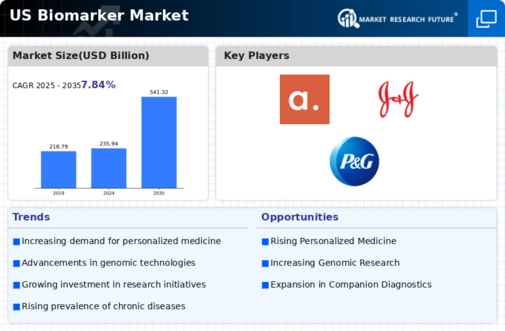Rising Incidence of Chronic Diseases
The increasing prevalence of chronic diseases such as cancer, diabetes, and cardiovascular disorders is a major driver for the biomarker market. According to the Centers for Disease Control and Prevention (CDC), chronic diseases account for 7 out of 10 deaths in the US, highlighting the urgent need for effective diagnostic tools. Biomarkers play a crucial role in early detection, prognosis, and treatment monitoring of these diseases. The demand for personalized medicine is also on the rise, as patients seek tailored treatment options based on their unique biomarker profiles. This trend is expected to boost the biomarker market significantly, with estimates suggesting a market value exceeding $50 billion by 2030. Consequently, healthcare providers are increasingly adopting biomarker-based diagnostics to improve patient outcomes.
Growing Investment in Precision Medicine
The biomarker market is benefiting from the growing investment in precision medicine initiatives. As healthcare shifts towards more personalized approaches, biomarkers are becoming essential for tailoring treatments to individual patients. The National Institutes of Health (NIH) has allocated substantial funding towards precision medicine research, which is expected to enhance the development of biomarker-based diagnostics and therapeutics. This investment is likely to foster collaborations between academic institutions and industry players, further driving innovation in the biomarker market. Additionally, the increasing number of clinical trials focusing on biomarker-driven therapies is indicative of the market's potential. With the precision medicine market projected to reach $100 billion by 2026, the biomarker market is poised for substantial growth.
Regulatory Support for Biomarker Development
Regulatory bodies in the US are increasingly recognizing the importance of biomarkers in drug development and diagnostics, which is positively impacting the biomarker market. The Food and Drug Administration (FDA) has established guidelines for the validation and approval of biomarker-based tests, streamlining the process for developers. This regulatory support is encouraging pharmaceutical companies to invest in biomarker research and development, as it reduces the time and cost associated with bringing new diagnostics to market. Furthermore, the FDA's initiatives to promote the use of biomarkers in clinical trials are likely to enhance the efficiency of drug development processes. As a result, the biomarker market is expected to expand, with a projected growth rate of around 10% annually over the next five years.
Increased Awareness and Education on Biomarkers
There is a growing awareness and education surrounding the role of biomarkers in healthcare, which is driving the biomarker market. Healthcare professionals and patients alike are becoming more informed about the benefits of biomarker testing for disease prevention, diagnosis, and treatment. Educational initiatives by medical organizations and advocacy groups are contributing to this trend, emphasizing the importance of biomarkers in personalized medicine. As awareness increases, so does the demand for biomarker-based tests, leading to a more competitive market landscape. The biomarker market is likely to see a rise in new entrants and innovations as stakeholders seek to meet the evolving needs of healthcare providers and patients. This heightened awareness is expected to contribute to a market growth rate of approximately 8% over the next few years.
Technological Advancements in Biomarker Discovery
The biomarker market is experiencing a surge due to rapid technological advancements in biomarker discovery. Innovations in genomics, proteomics, and metabolomics are enabling researchers to identify and validate biomarkers with unprecedented accuracy. For instance, next-generation sequencing (NGS) technologies have reduced the cost of genomic analysis significantly, making it more accessible for research and clinical applications. The market is projected to grow at a CAGR of approximately 12% from 2025 to 2030, driven by these advancements. Furthermore, the integration of artificial intelligence in data analysis is enhancing the efficiency of biomarker identification, thereby propelling the biomarker market forward. As a result, stakeholders are increasingly investing in these technologies to stay competitive in the evolving landscape.














Leave a Comment